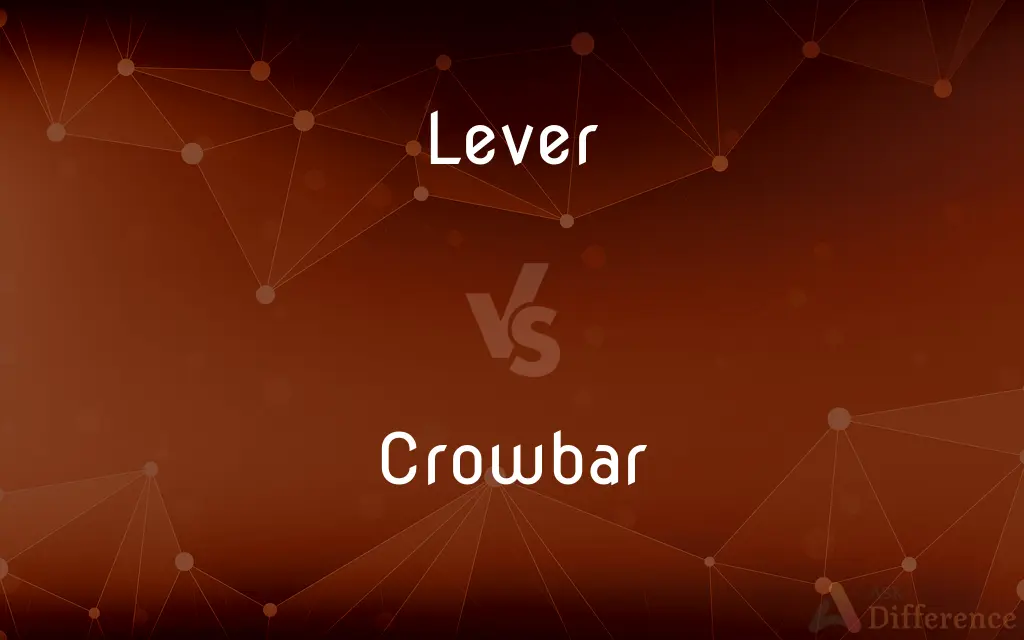Lever vs. Crowbar — What's the Difference?
Edited by Tayyaba Rehman — By Fiza Rafique — Updated on April 15, 2024
A lever is a simple machine that amplifies force, using a fulcrum and effort point, while a crowbar is a specific type of lever designed for prying or lifting heavy objects.

Difference Between Lever and Crowbar
Table of Contents
ADVERTISEMENT
Key Differences
A lever is a fundamental mechanical device that operates on the principle of moments, where force applied at one end is amplified at the other, around a pivot point known as the fulcrum. In contrast, a crowbar is a practical application of the lever principle, specifically engineered for construction and demolition tasks to apply large forces over shorter distances.
The design of a lever can vary significantly depending on its intended use, ranging from a simple wooden beam to more complex arrangements incorporating multiple fulcrums. Whereas a crowbar typically features a singular, curved end that acts as a fulcrum, and a flattened end that is inserted under objects to lift or pry them.
Levers are categorized into three classes based on the relative positions of the effort, load, and fulcrum. On the other hand, crowbars are generally considered first-class levers, where the fulcrum is positioned between the effort and the load, optimizing them for maximum force output with minimal effort.
The versatility of levers allows them to be used in a wide range of applications, from seesaws and scissors to catapults. Crowbars, however, are primarily used in construction and demolition, offering high leverage for tasks such as removing nails or prying apart boards.
While levers can be made from various materials tailored to their specific applications, crowbars are typically made from steel or other durable metals, designed to withstand the substantial forces applied during prying operations.
ADVERTISEMENT
Comparison Chart
Principle
Amplifies force using a fulcrum
Specific type of lever for prying
Design Variability
High, varies with application
Low, standardized design
Type
Can be first, second, or third class
Usually first-class
Common Uses
Broad, from toys to industrial machinery
Construction, demolition
Material
Varies (wood, metal, etc.)
Typically steel or durable metal
Compare with Definitions
Lever
Operates based on the principle of moments.
The lever’s effectiveness depends on the distance between the fulcrum and the effort point.
Crowbar
Typically a first-class lever.
The crowbar’s design places the fulcrum between the load and effort for maximum efficiency.
Lever
A simple machine that increases force.
Using a lever, the child easily lifted the heavy rock.
Crowbar
Essential in construction and demolition.
Every builder carries a crowbar for various tasks on the construction site.
Lever
Utilizes a fulcrum to change force direction or magnitude.
A seesaw is a popular example of a lever in a playground.
Crowbar
Designed as a durable, high-leverage device.
Made from steel, the crowbar easily handled the prying tasks at the demolition site.
Lever
Can be adapted for various mechanical purposes.
Engineers use levers in designs from bicycle brakes to aircraft controls.
Crowbar
Features a curved end for effective prying.
The curved end of the crowbar made it easy to lift heavy objects off the ground.
Lever
Categorized into three classes based on fulcrum, load, and effort arrangement.
Scissors are an example of a first-class lever where the fulcrum is between the load and the effort.
Crowbar
A tool primarily used for prying or lifting.
The worker used a crowbar to remove the old flooring.
Lever
A lever ( or US: ) is a simple machine consisting of a beam or rigid rod pivoted at a fixed hinge, or fulcrum. A lever is a rigid body capable of rotating on a point on itself.
Crowbar
An iron bar with a flattened end, used as a lever.
Lever
A rigid bar resting on a pivot, used to move a heavy or firmly fixed load with one end when pressure is applied to the other
A tyre lever
Crowbar
Use a crowbar to open (something)
He crowbarred the box open
Lever
Lift or move with a lever
She levered the lid off the pot with a screwdriver
Crowbar
A straight bar of iron or steel, with the working end shaped like a chisel and often slightly bent and forked, used as a lever.
Lever
A simple machine consisting of a rigid bar pivoted on a fixed point and used to transmit force, as in raising or moving a weight at one end by pushing down on the other.
Crowbar
To extract, remove, or insert forcibly
"[The newsmagazines] can crowbar stories in as late as Sunday and still be out on Monday" (Edwin Diamond).
Lever
A projecting handle used to adjust or operate a mechanism.
Crowbar
An iron or steel bar, often with a flattened end which may also be hook-shaped, to be used as a lever to manually force things apart.
Lever
A means of accomplishing; a tool
Used friendship as a lever to obtain advancement.
Crowbar
An electrical circuit that prevents an overvoltage from causing damage.
Lever
To move or lift with a lever
Levered up the manhole cover.
Crowbar
A type of cocktail made with only Crown Royal whiskey and lemon lime soda.
Lever
To move (oneself, for example) in a manner resembling the use of a lever
"[He] levered himself out the window all the way to his waist" (Stephen King).
Crowbar
(transitive) To force to move, usually with a crowbar; to prise.
He crowbarred the door open.
Lever
To fund at least in part with borrowed money; leverage.
Crowbar
A bar of iron sharpened at one end, and used as a lever.
Lever
(mechanics) A rigid piece which is capable of turning about one point, or axis (the fulcrum), and in which are two or more other points where forces are applied; — used for transmitting and modifying force and motion.
Crowbar
A heavy iron lever with one end forged into a wedge
Lever
Specifically, a bar of metal, wood or other rigid substance, used to exert a pressure, or sustain a weight, at one point of its length, by receiving a force or power at a second, and turning at a third on a fixed point called a fulcrum. It is usually named as the first of the six mechanical powers, and is of three kinds, according as either the fulcrum F, the weight W, or the power P, respectively, is situated between the other two, as in the figures.
Lever
A small such piece to trigger or control a mechanical device (like a button).
Lever
(mechanics) A bar, as a capstan bar, applied to a rotatory piece to turn it.
Lever
(mechanics) An arm on a rock shaft, to give motion to the shaft or to obtain motion from it.
Lever
A crowbar.
Lever
(rare) A levee.
Lever
(transitive) To move with a lever.
With great effort and a big crowbar I managed to lever the beam off the floor.
Lever
To use, operate or move (something) like a lever (physically).
Lever
To use (something) like a lever (in an abstract sense).
Lever
To increase the share of debt in the capitalization of a business.
Lever
(obsolete) Rather.
Lever
More agreeable; more pleasing.
Lever
Rather.
For lever had I die than see his deadly face.
Lever
A rigid piece which is capable of turning about one point, or axis (the fulcrum), and in which are two or more other points where forces are applied; - used for transmitting and modifying force and motion. Specif., a bar of metal, wood, or other rigid substance, used to exert a pressure, or sustain a weight, at one point of its length, by receiving a force or power at a second, and turning at a third on a fixed point called a fulcrum. It is usually named as the first of the six mechanical powers, and is of three kinds, according as either the fulcrum F, the weight W, or the power P, respectively, is situated between the other two, as in the figures.
Lever
A bar, as a capstan bar, applied to a rotatory piece to turn it.
Lever
A rigid bar pivoted about a fulcrum
Lever
A simple machine that gives a mechanical advantage when given a fulcrum
Lever
A flat metal tumbler in a lever lock
Lever
To move or force, especially in an effort to get something open;
The burglar jimmied the lock
Raccoons managed to pry the lid off the garbage pail
Common Curiosities
What makes crowbars so effective in construction?
Their sturdy construction and efficient leverage design make them ideal for heavy lifting and prying tasks.
Are there different types of levers?
Yes, levers are categorized into three types based on the positions of the load, effort, and fulcrum.
Can all levers be used like a crowbar?
No, levers vary widely in design and purpose, and not all are suitable for the heavy-duty tasks crowbars are designed for.
What are the common materials used to make levers and crowbars?
Levers can be made from wood, metal, or other materials, while crowbars are typically made from steel for durability.
How does the design of a crowbar enhance its functionality?
The design, including a curved end and flat lifting surface, optimizes it for prying and lifting heavy objects with minimal effort.
What educational value do levers have?
Studying levers helps understand basic physics concepts such as force, torque, and mechanical advantage.
Where is the fulcrum located on a typical crowbar?
The fulcrum on a crowbar is typically near one end, allowing the other end to be maneuvered under loads for effective leverage.
What distinguishes a lever from a crowbar?
A lever is a general mechanical principle, whereas a crowbar is a specific tool designed as a lever for prying and lifting.
How has the design of crowbars evolved over time?
Crowbar designs have evolved to incorporate ergonomic handles, varied sizes, and specialized ends for different types of prying tasks.
Can levers and crowbars be used interchangeably in mechanical setups?
While both operate on the same principle, their specific designs often make them suitable for different tasks.
What role does material strength play in the effectiveness of crowbars?
Strong materials ensure that crowbars can withstand the forces applied during prying without bending or breaking.
Are there innovations in lever designs that enhance their functionality?
Innovations often involve materials and design adjustments that optimize leverage, reduce weight, or increase durability.
What are the safety considerations when using a crowbar?
Proper handling to avoid injury and ensuring the crowbar is suitable for the weight and nature of the task are crucial safety considerations.
How do the mechanics of a lever apply in everyday tools?
Many everyday tools, from nail clippers to wheelbarrows, use the lever principle to reduce effort and increase efficiency.
Can the principles of levers be seen in modern machinery?
Yes, levers are integral to many mechanisms in modern machinery, enhancing functionality and control.
Share Your Discovery

Previous Comparison
Ascribe vs. Describe
Next Comparison
Bushido vs. SeppukuAuthor Spotlight
Written by
Fiza RafiqueFiza Rafique is a skilled content writer at AskDifference.com, where she meticulously refines and enhances written pieces. Drawing from her vast editorial expertise, Fiza ensures clarity, accuracy, and precision in every article. Passionate about language, she continually seeks to elevate the quality of content for readers worldwide.
Edited by
Tayyaba RehmanTayyaba Rehman is a distinguished writer, currently serving as a primary contributor to askdifference.com. As a researcher in semantics and etymology, Tayyaba's passion for the complexity of languages and their distinctions has found a perfect home on the platform. Tayyaba delves into the intricacies of language, distinguishing between commonly confused words and phrases, thereby providing clarity for readers worldwide.
















































